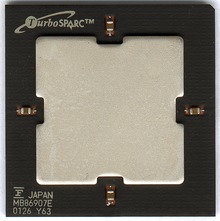TurboSPARC
 |
|
| Produced | 1996 |
|---|---|
| Designed by | Fujitsu Microelectronics, Inc. |
| Max. CPU clock rate | 160 MHz to 180 MHz |
| Instruction set | SPARC V8 |
| Cores | 1 |
The TurboSPARC is a microprocessor that implements the SPARC V8 instruction set architecture (ISA) developed by Fujitsu Microelectronics, Inc. (FMI), the United States subsidiary of the Japanese multinational information technology equipment and services company Fujitsu Limited located in San Jose, California. It was a low-end microprocessor primarily developed as an upgrade for the Sun Microsystems microSPARC-II-based SPARCstation 5 workstation. It was introduced on 30 September 1996, with a 170 MHz version priced at US$499 in quantities of 1,000. The TurboSPARC was mostly succeeded in the low-end SPARC market by the UltraSPARC IIi in late 1997, but remained available.
Users of the TurboSPARC were Force Computers, Fujitsu, RDI Computer, Opus Systems, Tadpole Technologies, Tatung Science and Technology and Themis Computers. Fujitsu used a 160 MHz version in a SPARCstation 5 upgrade kit, whereas the other companies used the 170 MHz version in workstation, notebook and embedded computers.
The performance of the 170 MHz TurboSPARC was similar to that of a 120 MHz Intel Pentium, but when compared to a 110 MHz microSPARC-II, it had two times the integer performance and one and a half times the floating-point performance.
The TurboSPARC was a simple scalar in-order design. During the fetch stage, two instructions were fetched from a 16 KB direct-mapped instruction cache. During the decode stage, one instruction was decoded, and its operands read from its register file. Execution began in stage three. The TurboSPARC had an integer unit and a floating-point unit. Most integer arithmetic instructions except for multiply and divide have a single-cycle latency. Multiply and divide was executed by the FPU. Multiply had a seven cycle latency while divide had an 8- to 33-cycle latency. Most floating-point arithmetic instructions except for divide and square-root had a four-cycle latency.
...
Wikipedia
